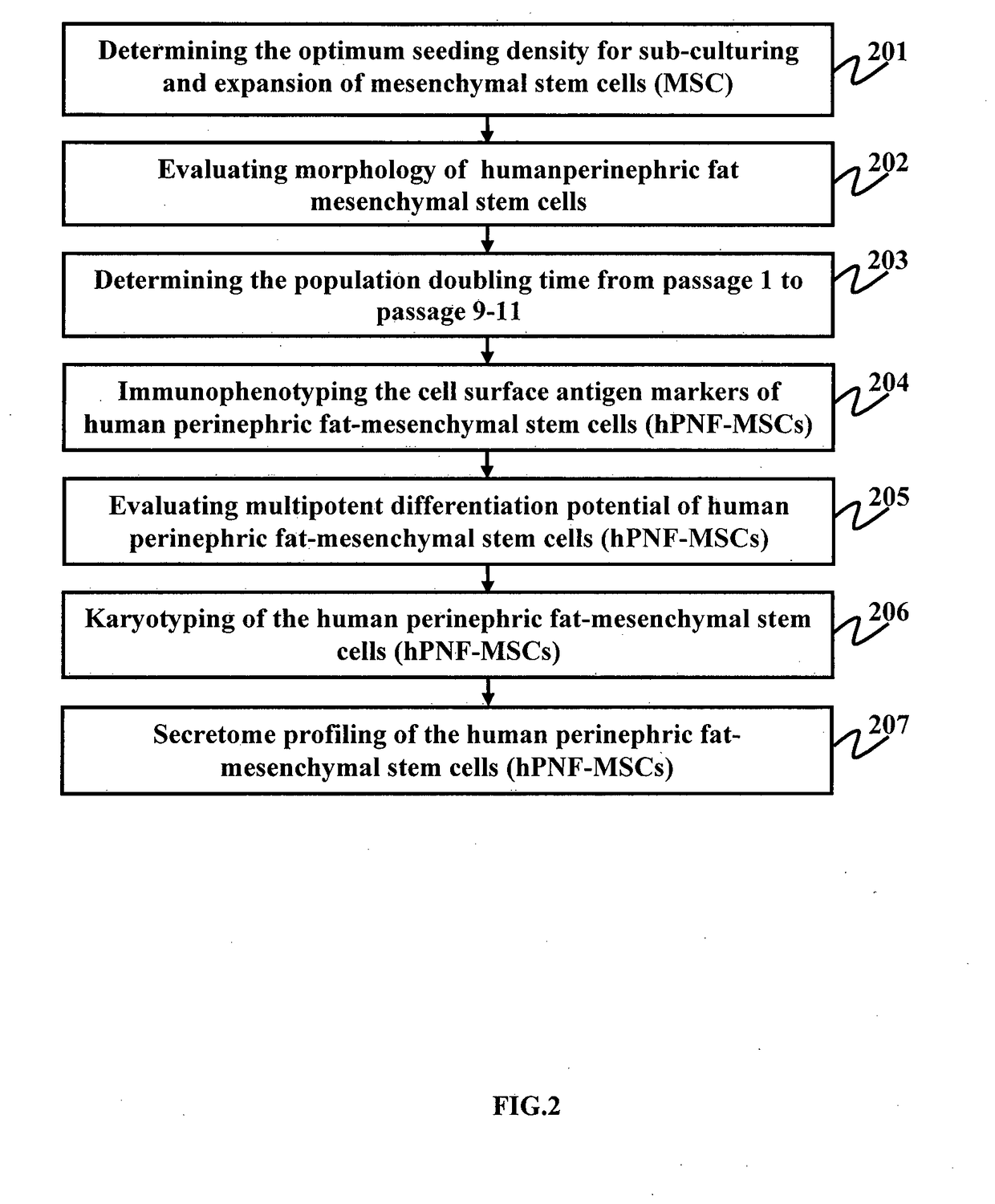A method for the regeneration and differentiation of human perinephric fat derived mesenchymal stromal cells into astroglial, renal, neuronal and pancreatic progenitor cells
a technology of perinephric fat and mesenchymal stromal cells, which is applied in the field of stem cells, stem cell regeneration and differentiation, can solve the problems of inability to provide immunosuppressive medications to patients at a significant cost, both financially and physically, and the inability to meet the immune system of the recipient, and achieve the effect of reducing the risk of infection
- Summary
- Abstract
- Description
- Claims
- Application Information
AI Technical Summary
Benefits of technology
Problems solved by technology
Method used
Image
Examples
example-1 , 1
Example-1,1—Optimization of Seeding Density
[0134]To determine the optimum seeding density for sub-culturing and expansion of MSCs, two different seeding densities were taken into consideration for one representative donor sample (PNF 2). At each passage cells were seeded at 1000 cells / cm2 low density (LD) and 2500 cells / cm2 high density (HD). Although expansion of MSCs after initial seeding was rapid in HD cultures, cells failed to maintain similar growth kinetics and morphology as LD cultures over late passages. Moreover, HD cultures showed cell senescence at P10, whereas LD cultures showed senescent at P15. Taken together, cells seeded at 1000 cells / cm2 showed considerably better growth kinetics than compared to high density cultures. Following optimization data, 1000 cells / cm2 seeding density was adopted for subsequent in vitro expansion of MSCs from donor samples (PNF 7 and PNF 4). FIG. 3 is a graph illustrating the population doubling time of the high and low seeding density cu...
example-1.2
al Evaluation of the Human Perinephric Fat-Mesenchymal Stem Cells (hPNF-MSCs)
[0135]FIG. 4 is a photograph illustrating the morphology of the human perinephric fat mesenchymal stem cells (hPNF-MSCs), according to an embodiment herein. The human perinephric fat-mesenchymal stem cells (hPNF-MSCs) show a typical fibroblast like morphology from all donor samples (FIG. 4). All the three samples maintained the typical-spindle shaped fibroblast-like morphology till P7. However, there was progressive change in morphology beyond passage 5. PNF-MSCs from early passages (P1-P5) showed rapidly growing (21.13±0.54 hrs at P5) thin spindle-shaped, slender and fibroblast-like morphology, whereas PNF-MSCs from late passages (beyond P5) showed morphologically polygonal shape and consisted slower growth rate (66.31±11.02 hrs at P7). At late passages, the cells appeared large, flattened, granulated with long processes. Cells from late passages showed vacuole formation within them. At passage 10, cells s...
example-1.3
on of the Population Doubling Time of Human Perinephric Fat-Mesenchymal Stem Cells (hPNF-MSCs)
[0136]The population doubling time was determined from passage 1 to passage 9-14. As demonstrated in the FIG. 1, the population doubling time (PDT) of cells from PNF 2 sample significantly increased from 14.38±1.29 hours at P2 to 235.85±0.65 hours at P9 (p<0.05) in case of high density cultures, whereas in case of low density cultures, PDT was observed to be 75.065±0.36 hours at P14. FIG. 5 is a graph illustrating the growth kinetics of the human perinephric fat mesenchymal stem cells (hPNF-MSCs), according to an embodiment herein. FIG. 5 also illustrates population doubling time (PDT) for donor sample PNF 4 and PNF 7. The PDT for PNF 7 sample significantly increased from 26.69±0.19 hours at passage P2 to 260.95±0.85 hours at passage P9. The PDT of PNF 4 donor sample is observed to be 24.920.92 hours, which is significantly similar to PDT of passage 6 P6 (26.66±5.3).
PUM
| Property | Measurement | Unit |
|---|---|---|
| pore size | aaaaa | aaaaa |
| concentration | aaaaa | aaaaa |
| temperature | aaaaa | aaaaa |
Abstract
Description
Claims
Application Information
 Login to View More
Login to View More - R&D
- Intellectual Property
- Life Sciences
- Materials
- Tech Scout
- Unparalleled Data Quality
- Higher Quality Content
- 60% Fewer Hallucinations
Browse by: Latest US Patents, China's latest patents, Technical Efficacy Thesaurus, Application Domain, Technology Topic, Popular Technical Reports.
© 2025 PatSnap. All rights reserved.Legal|Privacy policy|Modern Slavery Act Transparency Statement|Sitemap|About US| Contact US: help@patsnap.com



